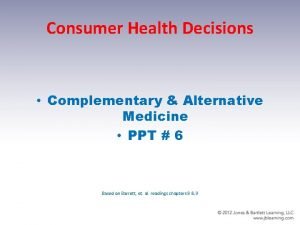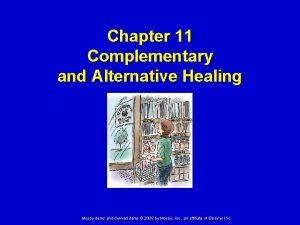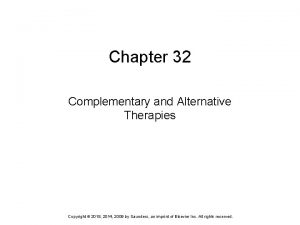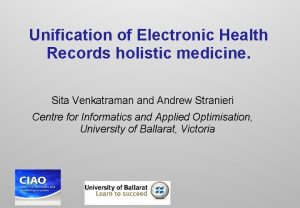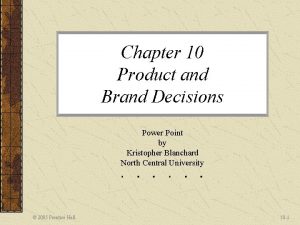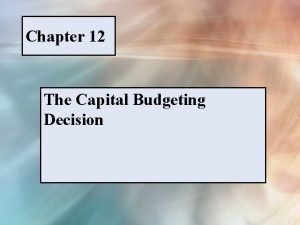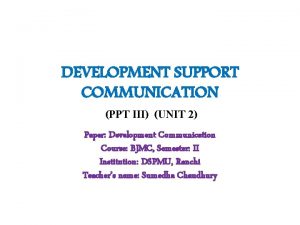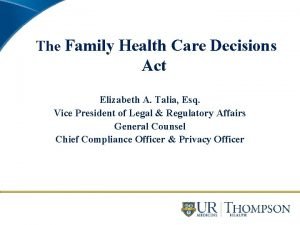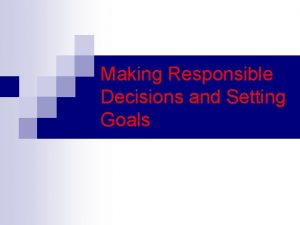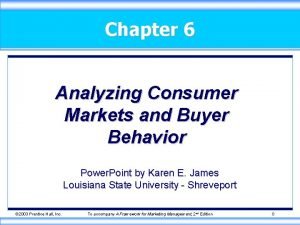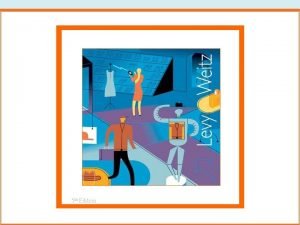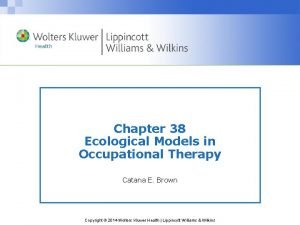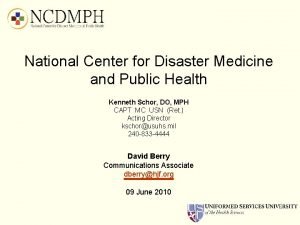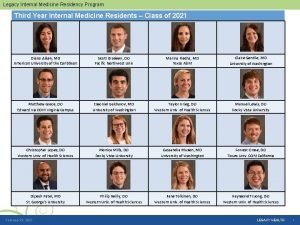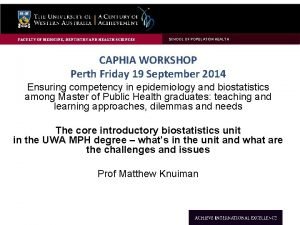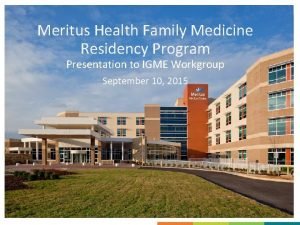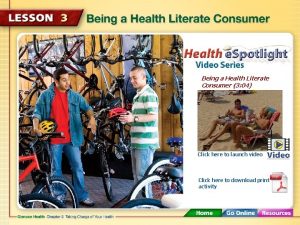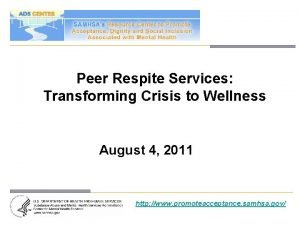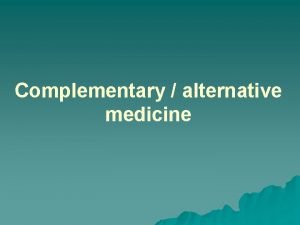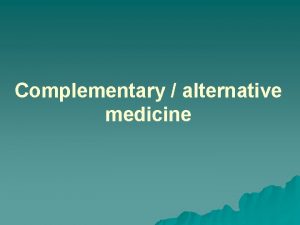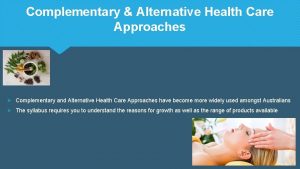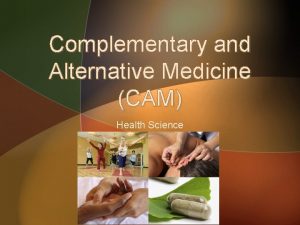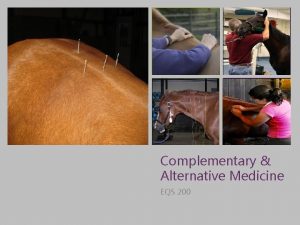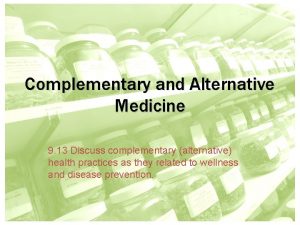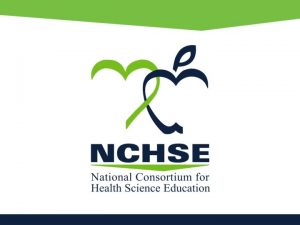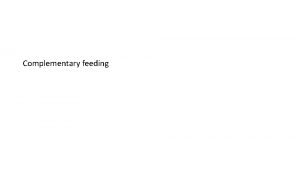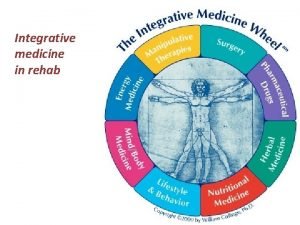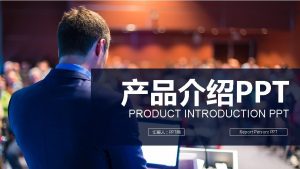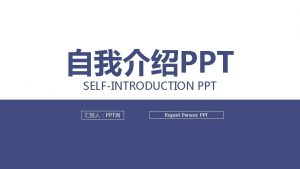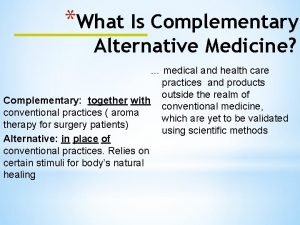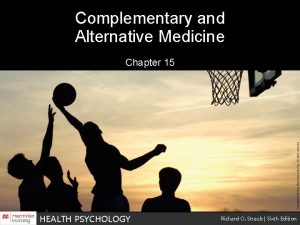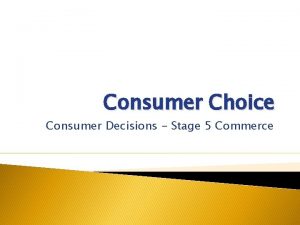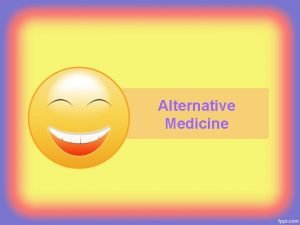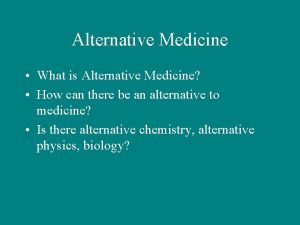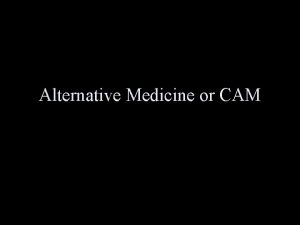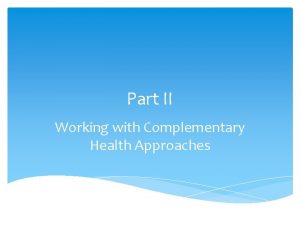Consumer Health Decisions Complementary Alternative Medicine PPT 6






























- Slides: 30

Consumer Health Decisions • Complementary & Alternative Medicine • PPT # 6 Based on Barrett, et. al. readings chapters 8 & 9

Topic Objectives • Distinguish among conventional medicine, complementary therapies, and alternative therapies. • Explain integrative therapy. • Explain the five categories of complementary and alternative medicine. • Discuss the reasons for the popularity of complementary and alternative medicine and the characteristics of people most likely to use them. • Explain the tenets supporting several complementary and alternative therapies. • List the information needed to decide on using a complementary or alternative therapy and identify sources of that information.

Conventional Medicine • That which has undergone extensive _______in _______ trials and has been shown to exceed some agreed upon standards of _______ and _______. • Also called _______ or allopathic medicine.

Definitions • _______ therapy: a remedy that has not been shown by scientific study to be safe and effective but is used in place of conventional (allopathic) medicine. • _______ therapy: a therapy that has not been accepted as conventional medicine but is used together with conventional(allopathic) medicine.

CAM Philosophies • Facilitate the body to _______ itself: i. e. boost the _______ system. This is better then antibiotics • Emphasize _______(boost immune system, stress relief & management, spiritual congruence, etc. ) • Patient _______ themselves, the practitioner guides them (responsibility shifts to patient)

Background/History • Before Mod. Med. the sick turned to folk medicine, shamans (witch doctors, mediums, etc. ) • Put a penny on a wart then bury it, chants, herbs, rituals, etc. • 1800 s science based medicine took root & began to grow, licensing and medical schools were established. • Folk practitioners were not licensed thus competition between the two approaches developed

Background/history • Allopathic docs. saw folk docs as hucksters, scammers who were taking advantage of the sick and desperate. • 1970 s- CAM became popular again as health care costs increased & service decreased • Today some complementary practices are recommended by doctors and proven to be advantageous by science. This is especially true in areas such as _______, and _______

Background • 1998 NIH founded the National Center for Complementary and Alternative (Now Integrative) Medicine which supports research in these areas • 7500 trials in 2008 • As research supports a CAM treatment it leaves the category and becomes “_______” medicince. (e. g. fish oil supplements to treat heart disease).

Categories of CAM • _______ built on systems e. g. traditional Chinese Medicine, Ayurveda (traditional medicine of India). Centers around a philosophy/lifestyle • _______ to enhance the mind’s capacity to affect bodily function & symptoms, e. g. meditation, prayers, yoga, biofeedback, mental healing, etc. • _______ based therapies- Use of natural substancesherbs, foods, vitamins (e. g. shark cartilage to treat cancer) • _______ and body-based methods-based on manipulation of a body-part e. g. chiropractic, massage, reflexology, etc. • _______ therapies-Bio-field- pressure touch by hands relieves improves flow e. g. Reiki, Therapeutic Touch, electromagnetic therapies

Popularity of CAM in the U. S. • National Health Interview Survey 2007: • $33. 9 billion spent on CAM practitioners, products, nad services • 38 million adults made and estimated 354 visits to CAM practitioners • Most common: Non-vitamin, non mineral natural products (herbal teas, supplements, etc. ), meditation, chiropractic manipulation, massage and yoga. • .

Homeopathy • Law of Similars: if a large amount of a substance causes certain symptoms in a healthy person, smaller amounts of the same substance can treat those symptoms in an ill person. • Law of Infinitesimals: a substance’s strength and effectiveness increases the more it is diluted. • _______ remedy: the belief that one remedy would cure all symptoms; now mostly rejected by homeopathists. • Chronic diseases are simply manifestations of a suppressed itch or psora; now abandoned.

Regulation of Homeopathic Remedies • Regulated by the FDA in similar manner as nonprescription drugs. • Manufacturers are excused from submitting new drug applications to the FDA. • Products are exempt from some good manufacturing practice requirements. • If they are claimed to cure a serious disease, they may only be sold by prescription. • Regulation and licensing among the states is inconsistent. • Only three states license medical doctors to practice homeopathy.

Naturopathy • Also referred to as “natural medicine” used to “assist nature” to promote the body’s natural healing processes. • Emphasize prevention • Utilizes processes and products to rid the body of waste products and toxins. • Methods include fasting, natural foods, vitamins, herbs, massage, exercise, colon irrigation, natural childbirth, etc. • Proponents: it combines traditional therapies with some modern medicine practices (used radiation for diagnostics but not treatments). • Critics: it is largely pseudoscientific and fails to meet _______ of scientific evidence of effectiveness and safety.

Naturopathy • Based on vitalism, or “life force” an energy or characteristic of the body to live and function at a high level. This is distinct from forces and processes explained by physics and chemistry. • Science contradicts vitalism. • Not covered by Medicare or most health insurance policies • Doctor of Naturopathy degree: 1. Four year degree with prerequisite science courses included, then four years at a Naturopathic university which includes two years of clinical experience. 2. Licensed and legally practice in 16 states, mostly in the west.

Ayurveda – Traditional in India • “Validated” by observation, inquiry, direct examination, and ancient _______ rather than science. • More of a way of _______ than a treatment. • Uses a “constitution model” that provides guidance regarding food and lifestyle. • Views a human as made up of _______ primary elements: ether, air, fire, water, and earth. • The combination of these elements makes individuals unique. • Three “doshas” hold primary influence – vata, pitta, and kapha.

Ayurveda • There is no state or national licensing. • There is no governmental regulation in the U. S. • Standards of competency are set by individual schools.

Reiki – Traditional in Japan • A system of _______ energy to someone for healing. • Adherents believe that Reiki directs the energy that makes up the universe to the people, places, and things where there is a difference between the current form and the ideal form. • In one form, Reiki energy flows from the practitioner’s hands to the patient, treating health problems and improving mental clarity, well-being, and spirituality.

Yoga • Exploration of the eight limbs of yoga refines behavior in the outer world and allows us to focus inwardly. • There are six branches of yoga: hatha (the physical), raja (meditation), karma (service), bhakti (devotion), jnana (the mind; wisdom), and tantra (sexuality) • In the West, many people use it for _______, _______ relief, and _______. • Often used as a complementary therapy

Chiropractic additional info in chapter 9 • Primary concept: a properly functioning _______ system is the key to health. • Emphasizes the _______ and nerves. • The primary technique is spinal manipulation. • Some chiropractors claim to treat conditions not associated with the spine. • Practitioners often discourage use of medications. • Some chiropractors use other alternative practices such as herbal and reflexology. • Some practitioners refer patients to physicians. • Some physicians refer patients to chiropractors.

Regulation of Chiropractic • Licensed and regulated in every state • Colleges of chiropractic are regulated through the process of accreditation. • Usually covered by insurance to treat certain conditions for a limited number of visits

Acupuncture – Traditional in China • Based on the belief that the vital force chi regulates spiritual, emotional, mental, and physical balance. • Chi is influenced by opposing forces, _______ and _______ • Acupuncture is said to keep the normal flow of chi clear and unblocked, balancing yin and yang. • Energy flows through _______ in the body. • Acupuncture points along the meridians are stimulated with needles, manual pressure, electricity, or other means.

Acupuncture • There is __correlation between meridians and actual position of organs and nerves. • Most often used for pain relief in the West. • Mainly used as complementary therapy in the U. S.

Regulation of Acupuncture • Over 30 states have specific laws regarding acupuncture, including licensing and certification. • FDA has approved acupuncture needles for use by licensed practitioners. • In states that do not recognize acupuncturists, they may practice under the supervision of a licensed physician.

Reflexology • The parts of the body coincide with specific areas on the feet, hands, ear, and hand. • Pressure and massage on those specific areas promotes _______.

Faith Healing • Prayer, divine intervention, or the ministrations of the healer can cure illness. • The practice is based on faith.

Christian Science • Founded by Mary Baker Eddy • It is neither Christian nor _______ • A form of faith-healing based on Mary Baker Eddy’s interpretation of the Bible that is not held by the vast majority of Bible Scholars, Pastors, or Christian religions. • A system of spiritual, prayer-based healing • Practitioners usually _______ traditional medical treatments.

Scientology pp. 105 -106 • Originated in Dianetics by L. Ron Hubbard • Evolved into the Church of Scientology • “Auditing” discovers destructive elements called “engrams. ” • Considers many established conditions, e. g. asthma, arthritis, and ulcers to be psychosomatic. • The Church of Scientology operates a chain of clinics.

Herbs and Dietary Supplements • Not treated as drugs, so they can be marketed without testing the truthfulness of their claims • “Natural” does not mean _______ or effective. • Can cause adverse reactions, especially when combined with prescription or OTC drugs. • Taking too much can cause results in adverse effects on one’s health

Considering CAM? • Obtain unbiased information about safety, effectiveness, and processes from: § Your physician § Scientific literature § The National Center for Alternative and Complementary Medicine • Study the claims being made. Do they sound reasonable? • Consider how the product or service is being marketed. • Consider how widely available it is.

Two Important Considerations • By definition, alternative therapies lack scientific evidence of safety and effectiveness. • Using them may result in a delay in obtaining conventional treatment.
 Alternative therapy ppt
Alternative therapy ppt Meaning of poster making
Meaning of poster making Chapter 11 complementary and alternative medicine
Chapter 11 complementary and alternative medicine Food web diagrams
Food web diagrams Chapter 32 complementary and alternative therapies
Chapter 32 complementary and alternative therapies Screening decisions and preference decisions
Screening decisions and preference decisions Holistic medicine emr
Holistic medicine emr Decomposer in the sahara desert
Decomposer in the sahara desert Consumer diversity in consumer behaviour
Consumer diversity in consumer behaviour Consumer research process
Consumer research process Buyer behaviour
Buyer behaviour Consumer markets and consumer buyer behavior
Consumer markets and consumer buyer behavior Branding decisions ppt
Branding decisions ppt Capital budgeting decisions ppt
Capital budgeting decisions ppt Participatory communication ppt
Participatory communication ppt Use of alternative energy sources ppt
Use of alternative energy sources ppt Fhcda
Fhcda Setting health goals and making responsible decisions
Setting health goals and making responsible decisions Analyzing consumer markets ppt
Analyzing consumer markets ppt Retail consumer behaviour ppt
Retail consumer behaviour ppt Monash university master of public health
Monash university master of public health Faculty of medicine nursing and health sciences
Faculty of medicine nursing and health sciences Confluence health occupational medicine
Confluence health occupational medicine National center for disaster medicine and public health
National center for disaster medicine and public health Neysan pucks
Neysan pucks Duke medicine grand rounds
Duke medicine grand rounds Pubh4401
Pubh4401 Meritus family medicine
Meritus family medicine Being a health literate consumer
Being a health literate consumer Being a health literate consumer
Being a health literate consumer Peer respite centers
Peer respite centers
